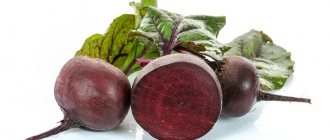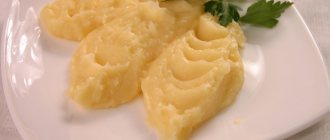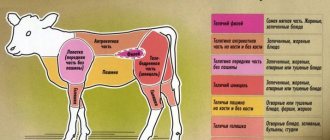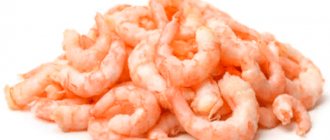At what age can children be given cabbage, what vitamins and microelements it contains, as well as recipes for children’s dishes that can be prepared from cabbage in our material.
Cabbage is the name of a two-year-old herbaceous plant and the fruit of the same name. Cabbage came to us from the Mediterranean coast around the 9th century and we loved it very much. Already in the 12th century, cabbage was cultivated throughout Rus'. Later, cabbage became a staple food.
Chemical composition and benefits of ordinary cabbage
Cabbage is 90% water, the rest is carbohydrates - 6%, including fiber, and proteins - 2%. Cabbage has a very high content of vitamin C (ascorbic acid), as well as vitamins B1, B2, PP, A, E and K. In addition, it contains a lot of potassium, calcium, magnesium and other minerals. Cabbage and fresh juice from it contain a complex of substances that help heal ulcerative defects of the mucous membrane, with reduced secretion. After consulting with your doctor, you can use cabbage to treat certain intestinal and liver diseases.
It is useful for problems such as:
- avitaminosis;
- bronchitis;
- haemorrhoids;
- headache;
- overweight.
Cabbage is a low-calorie product, it contains only 28 kcal. per 100g, so it is also used if you are overweight. If you are prone to constipation, cabbage is recommended due to its high dietary fiber content. However, it can cause bloating and gas in some children.
Cabbage stores very well, so it is used in the diet almost all year round and in a wide variety of forms: fresh salads, side dishes, pies, borscht, sauerkraut. Surely every housewife has her own simple salad recipes, in which the main ingredient is cabbage - this is a very common vegetable. The daily intake of cabbage is up to 100 g.
Fresh cabbage is considered the healthiest. However, it should be stored properly so that it retains its vitamins throughout the long winter. Moreover, the content of ascorbic acid in it practically remains all year round. Vitamins are perfectly preserved in both fresh and sauerkraut.
At what age can a child be given white cabbage?
White cabbage is a well-known tasty and healthy vegetable that makes excellent cabbage soup, unusually tasty cabbage rolls and salads rich in vitamins. Its leaves, used for cooking, contain coarse fibers of fiber and sulfur, which have an irritating effect on the mucous membranes of the children's intestines and stomach, as a result of which children experience flatulence, abdominal pain and stool disturbances. If the baby’s main food is mother’s milk, and the mother’s diet includes cabbage, then introducing this vegetable into complementary foods is not accompanied by any problems.
Cabbage in children's nutrition
Some types of cabbage are advised to introduce crumbs into the diet after 5-6 months. But not all cabbage is equally beneficial for a baby's tummy. For example, kohlrabi and cabbage can cause bloating because they contain coarse polysaccharides that are difficult to digest. Without fear, you can offer your baby cauliflower and broccoli, which are considered dietary foods.
It is cauliflower and broccoli that occupy a priority place among the vegetables with which complementary feeding begins. These vegetables contain more delicate fiber compared to white cabbage and do not irritate the gastric mucosa.
Despite all the benefits of sauerkraut, it is recommended to give it, even washed, to children after three years of age. Most children do not like cabbage in borscht and soups. And for good reason: there it loses most of its beneficial properties. But many children love to chew on the stalks - it’s both healthy and tasty. Just don’t give children the cores from the first heads of cabbage, the earliest ones.
Broccoli for a child - what are the benefits and how to cook it for a child
Raw cabbage is not suitable for feeding children - foods for children require heat treatment. This also applies to broccoli. This type of cabbage can be boiled, steamed, or stewed.
Broccoli is very high in vitamin C - only lemons have more! Moreover, this cabbage contains vitamin C not in the form of ascorbic acid, but in the form of ascorbigen, which is not destroyed during storage. So, you can feed your baby a healthy product throughout the year.
In addition, broccoli is rich in essential amino acids, which is why its nutritional properties can be put on par with chicken egg whites and beef.
Cauliflower in baby food
I would also like to say something about cauliflower. It has a completely different structure, taste, and vitamin and mineral composition than its white cabbage sister. There is almost 1.5 times more ascorbic acid in cauliflower than in cabbage or kohlrabi. It is superior to its relatives in the content of vitamin PP, and it contains exactly twice as much vitamins B1 and B2. The protein in cauliflower is also twice as much as in white cabbage. It is also rich in potassium, magnesium and iron. You need to cook it carefully in order to preserve all the beneficial substances - if you boil it, then do it under the lid and for only a short time.
It’s not for nothing that cauliflower is called a dietary product - it is very low in calories: there are only 29 kcal per 100g of product. But at the same time it satisfies hunger well. In addition, cauliflower puree is the recommended first food for a baby, along with vegetables such as zucchini.
At what age can you give stewed cabbage?
Please tell me, girls, at what age can you give stewed cabbage?
When can you start giving juice slowly?
by Adminrive · Published 12/28/2013
Many people have written here about spending time together with children.
by Adminrive · Published 02/26/2014
by Adminrive · Published 12/20/2012
- Comments 9
- Pingbacks 0
I've been giving all possible cabbage rolls since a year, maybe earlier
Since I was a year old I have been giving it stewed with meat and vegetables.
When I was 9 months old I gave him cabbage, potatoes and meat stew. Everything seemed to be fine.
We started after a year
After a year, somewhere from 1.4
I've been giving since I was 9 months old. But in the form of a soup with other vegetables
Also read: How to take Elevit pronatal when planning
After a year
Nadyusha, white cabbage can cause increased gas formation in babies. A small amount of stewed cabbage can be offered to a child after one year with the permission of the attending doctor. It is recommended to give vegetables, and especially cabbage, to the baby in the morning or lunchtime, so as not to stimulate an increase in gas formation before bedtime. All new products are introduced gradually, starting with ½ teaspoon if the baby does not react.
Since I was a year old I have been giving it stewed with meat and vegetables.
Another type of cabbage is Savoy
Savoy cabbage differs from white cabbage in having corrugated, wrinkled leaves of different shades of green.
In Western European countries, France and Italy, where Savoy cabbage is common, it is called Milanese. Savoy cabbage tastes like cauliflower.
Raw cabbage is used to prepare salads, it is added to soups and used to prepare various vegetable dishes: casseroles, stews, cabbage rolls. But this cabbage is not suitable for pickling.
This vegetable is a very valuable dietary product. In terms of nutritional and taste properties, it is superior to white cabbage: it is more tender and contains less fiber.
Nature does not deprive Savoy cabbage of vitamins: it contains a lot of vitamins B, A, and ascorbic acid. Among the mineral substances in Savoy cabbage, you can find sulfur, iron, nitrogenous substances, half of which are easily digestible proteins. In terms of protein content, this type of cabbage is a champion among its cabbage counterparts.
Savoy cabbage is necessary for older people. It contains a lot of not only phosphorus and calcium, but also potassium, which is necessary for the functioning of the heart muscle, which predominates in the leaves of this type of cabbage.
You can grow Savoy cabbage in the same way as white cabbage. When purchasing, you need to pay attention to the leaves: they should not be spoiled.
In what form to give
Feeding cabbage starts with mashed potatoes and pureed soups. Then you can introduce stewed cabbage with other vegetables. After a year they include soups and casseroles, stews, dishes with meat and poultry. Do not give your children fried vegetables, as they are difficult to digest and cause heaviness in the stomach. In addition, when frying, the product loses most of its beneficial properties and elements.
Light vegetable soups are perfect. Start cooking with vegetable broth, and then move on to chicken and beef. Children's cabbage soup can be given as early as one year of age. Borscht is a heavier dish that is recommended for children only after two years. The beets and cabbage in this recipe are difficult and take a long time to digest and can cause a negative stomach reaction. And what soups are suitable for babies, see here.
If the baby tolerates cabbage well, salads with fresh vegetables can be introduced at two years of age. But many pediatricians do not advise introducing fresh, raw food before three years of age. Give preference to baked and boiled vegetables. Next, we offer cabbage dishes that you can prepare for your child.
Also read: What Happens During the 11th Obstetric Week of Pregnancy
Culinary processing of cabbage
Cabbage can be cooked boiled, fried, stewed, baked, as well as in the form of cutlets, balls, schnitzels, etc. All cabbage dishes are prepared as independent dishes, some of which also serve as a side dish for hot and cold dishes.
How to cook cabbage: cold processing cabbage
Contaminated and darkened leaves of white, red and savoy cabbage are cut off, the head of cabbage is cut in half, the stalk is removed, the head of cabbage is cut into pieces of the appropriate shape and size and washed in water.
The cauliflower is cleaned of green leaves, and the stalk is cut off at the beginning of the branching of the head. The contaminated and yellowed surface of the head of cabbage is scraped off with a knife or removed by rubbing the head of cabbage with coarse salt, and then it is soaked for 10-15 minutes in salted water.
Brussels sprouts are cut from the stem, cleaned of spoiled leaves, and washed in water.
Heat treatment of cabbage
Processed cabbage: white cabbage, cauliflower, Brussels sprouts and Savoy cabbage is boiled until tender in boiling salted water (10 g of salt per 1 liter of water). Then take it out with a slotted spoon, let the water drain and place it on a dish or plate. After cooking, Brussels sprouts are placed in a sieve and cooled with water. It is better to boil white and savoy cabbage not in water, but in a small amount of meat broth in a container with a lid.
Cabbage for salads
Housewives know how to cook cabbage that has not undergone heat treatment. It is possible to prepare salads from raw vegetables in combination with other products: vegetables, eggs, meat, sausages, even fruits. Such salads contain a lot of vitamins and minerals, because for their preparation we use products that have not been subjected to heat treatment, after which, as is known, most vitamins are destroyed. Now there are a lot of websites, books and magazines where you can find salad recipes for every taste and budget.
At what age can it be given?
- White cabbage can be given to a child under one year old, but only after introducing him to other vegetables - zucchini, cauliflower, carrots, pumpkin, potatoes, broccoli and others. It is recommended to add white cabbage to vegetable dishes for a child no earlier than 7-8 months of age.
- In fresh form, it can be included in the menu of a child from 3 years old, provided that the baby does not have diseases of the digestive tract, for example, gastritis or pancreatitis. In addition, the child must chew the food well enough to consume it.
- The stalk is considered a harmful food, since various harmful compounds accumulate in it during the ripening of the vegetable. For this reason, children should not be given the stalk.
- In fermented form, it is acceptable in the diet of children over 3 years old, but in small quantities.
How long should you cook fresh and frozen broccoli after boiling?
How long should you cook broccoli?
Broccoli is very similar to cauliflower florets, only green. Fresh cabbage is boiled in salted water for 5-7 minutes from the moment it boils . If you bought frozen broccoli , then you need to cook it for longer than 12-15 minutes .
The following spices are suitable for boiled broccoli::
- Mustard
- Khmeli-suneli
- Ground black pepper and paprika
- Basil
- Thyme
- Rosemary
The following sauce also goes well with boiled broccoli.
Recipe:
- In a frying pan in 100 g of butter, fry 2 tbsp. spoons of flour until golden brown, dilute with 1 glass of broccoli broth .
- Add salt, ground black pepper to your taste, 4 sprigs of finely chopped dill to the sauce, and let it simmer for about 15 minutes.
- Beat 3 egg yolks
How long to cook cabbage for soup, borscht, cabbage soup after boiling?
How long should you cook cabbage for soup, borscht and cabbage soup?
finely chopped white cabbage for borscht, soups, cabbage soup into the pan at the end of cooking and cook for about 10 minutes .
It should be noted that some people like their cabbage to be crispy . This is how it will turn out if you throw the cabbage into a pan after frying, where there is tomato paste, and cook for 2-3 minutes.











